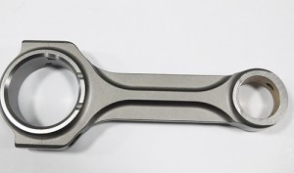Connecting rods are crucial components in an internal combustion engine, playing a vital role in transferring the reciprocating motion of the pistons to the rotational motion of the crankshaft.
They are responsible for ensuring smooth engine operation and directly impact performance, efficiency, and reliability.
In this article, we’ll explore the different types of connecting rods – H-beam, I-beam, and X-beam – and how their unique shapes and forged materials can enhance the functionality of your car’s engine, as well as your overall driving experience.
H-Beam Connecting Rods
H-beam connecting rods, named for their H-shaped cross-section, provide excellent strength and durability.
This design enables them to withstand high amounts of stress, making them ideal for high-performance engines or vehicles subjected to demanding driving conditions.
Forged from high-quality materials, H-beam rods ensure long-lasting performance and resistance to fatigue.
I-Beam Connecting Rods
I-beam connecting rods, featuring an I-shaped cross-section, are known for their lightweight design, which strikes a balance between strength and weight.
This design is well-suited for street and mild racing applications, as it allows the engine to rev more quickly, improving overall performance.
Like their H-beam counterparts, I-beam connecting rods are forged for enhanced strength and durability.
X-Beam Connecting Rods
X-beam connecting rods are a relatively new innovation in engine components.
These rods showcase a unique X-shaped cross-section, combining the best aspects of both H-beam and I-beam designs.
They offer exceptional strength while maintaining a lightweight structure, making them an excellent choice for high-performance applications where weight reduction is essential.

All three types of connecting rods are manufactured using a forging process, which provides numerous advantages over other methods.
Forged connecting rods have a more refined grain structure, resulting in improved strength, durability, and resistance to fatigue.
These properties make them a top choice for high-performance engines and challenging driving conditions.
As a car owner, upgrading your vehicle’s engine with forged connecting rods can lead to noticeable improvements in performance, reliability, and overall driving experience.
Whether you’re a casual driver or a dedicated racing enthusiast, investing in high-quality forged connecting rods can make a world of difference in how your engine performs.
In conclusion, connecting rods are a critical element in determining the performance of a car’s engine.
Choosing the right type of connecting rod – H-beam, I-beam, or X-beam – can significantly enhance your vehicle’s capabilities.
With the added benefits of forged materials, these connecting rods promise exceptional strength and durability, providing you with a more enjoyable and reliable driving experience.
By understanding the various types of connecting rods and selecting the best option for your engine, you can unlock your vehicle’s full potential and elevate your driving experience to new heights.
Material Options for Forged Connecting Rods
In addition to shape and design, the material used in manufacturing connecting rods plays a significant role in their performance.
Most commonly, forged connecting rods are made from either 4340 or 7075 aluminum alloy.
4340 is a high-strength steel alloy, offering excellent tensile strength and durability. It is perfect for high-horsepower applications and extreme conditions.
On the other hand, 7075 aluminum alloy is lighter in weight, making it ideal for applications where reducing mass is crucial.
Both materials provide excellent fatigue resistance and longevity.

Factors to Consider When Choosing Connecting Rods
When selecting the ideal connecting rod for your engine, it’s essential to consider various factors, such as the intended use of your vehicle (street driving, racing, or off-roading), your budget, and the specific performance goals you hope to achieve.
Each type of connecting rod offers unique benefits, and understanding their individual characteristics will allow you to make an informed decision that best suits your needs.
The Importance of Proper Installation and Maintenance
To fully benefit from the performance-enhancing capabilities of forged connecting rods, proper installation and maintenance are crucial.
Ensure you have a qualified professional install your connecting rods, as incorrect installation can lead to engine failure or damage.
Additionally, regular maintenance, such as oil changes and periodic inspections, will ensure your connecting rods continue to function optimally and extend their lifespan.
The Impact of Connecting Rods on Fuel Efficiency
The use of lightweight connecting rods can also have a positive impact on your vehicle’s fuel efficiency.
By reducing the rotating mass within the engine, lightweight rods allow for smoother and more efficient operation.
This results in better fuel consumption, lower emissions, and reduced operating costs.
In summary, the world of connecting rods offers a wealth of options for those seeking to enhance their engine’s performance.
By considering factors such as shape, material, and intended use, you can make a confident decision that leads to improved engine capabilities and an unparalleled driving experience.
Whether you choose H-beam, I-beam, X-beam, or custom connecting rods, the right choice will bring you closer to unlocking your engine’s true potential.
By taking the time to understand the various types of forged connecting rods and selecting the best option for your specific needs, you can transform your engine’s performance and elevate your driving experience to new levels.
Remember, the right connecting rods can make all the difference in how your engine performs, so invest wisely and enjoy the benefits of a powerful, efficient, and reliable engine.
